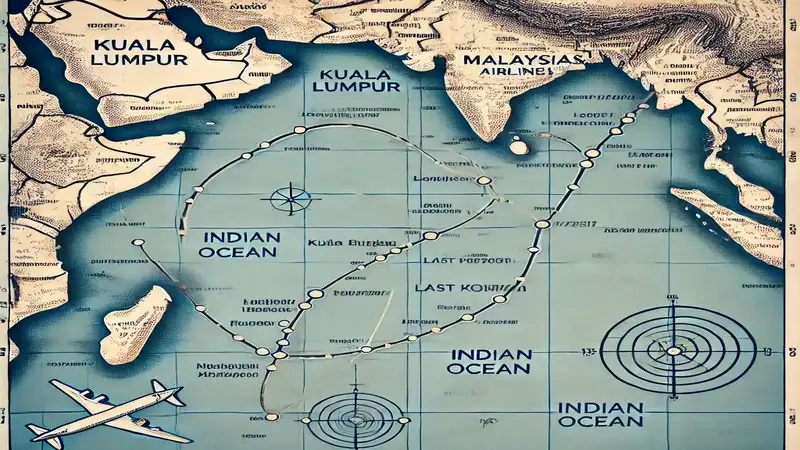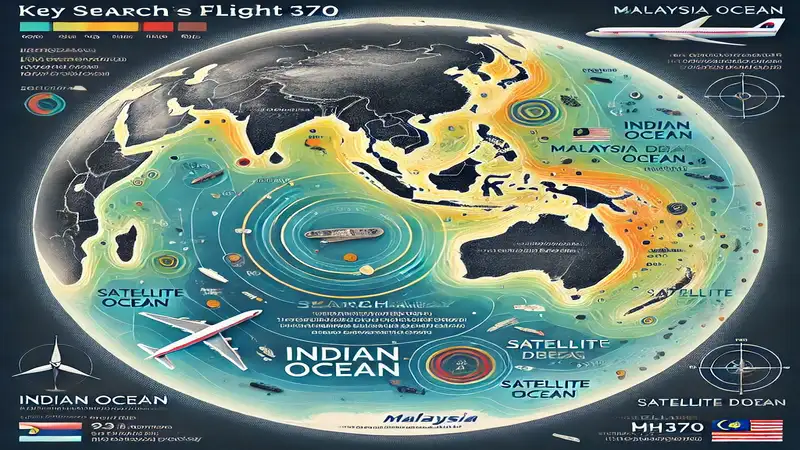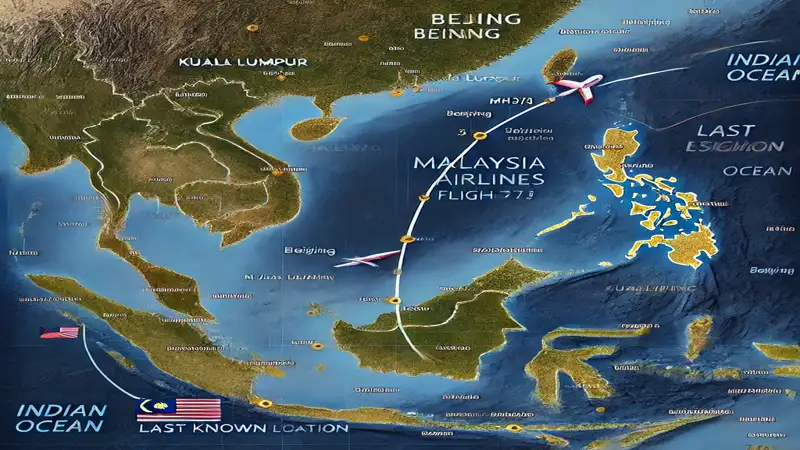The disappearance of Malaysia Airlines Flight 370 on March 8, 2014, remains one of the greatest aviation mysteries of all time. Over the years, various search operations have attempted to locate the missing Boeing 777, yet the aircraft’s fate remains unknown. Interestingly, Malaysia Airlines Flight 370 Google Maps has become a key tool for investigators and enthusiasts trying to uncover possible clues about its final location.
Flight MH370, carrying 239 passengers and crew, vanished mid-flight while traveling from Kuala Lumpur to Beijing, sparking one of the most extensive search missions in history. Despite numerous theories and deep-sea explorations, the wreckage has never been fully recovered. This tragic event continues to haunt the families of those on board, leaving them with unanswered questions. The Malaysia Airlines Flight 370 Google Maps search efforts reflect the global commitment to solving this decade-old aviation mystery.
MH370 Airline Disappearance and Initial Search Efforts
On the night of March 8, 2014, Malaysia Airlines Flight 370 took off from Kuala Lumpur International Airport at 12:41 AM, bound for Beijing. The last known communication occurred at 1:19 AM, as the aircraft transitioned from Malaysian to Vietnamese airspace over the South China Sea. Shortly after, the plane’s transponder was deactivated, and MH370 veered off its planned course, sparking one of aviation’s biggest unsolved mysteries.
In the initial days, search and rescue teams focused on the South China Sea, but as no debris was found, the operation expanded significantly. Satellite data analysis suggested that Malaysia Airlines Flight 370 Google Maps efforts should shift toward the southern Indian Ocean, where signals indicated the plane may have continued flying for several hours before vanishing. Despite extensive investigations, Malaysia Airlines Flight 370 Google Maps searches continue to fuel speculation and theories about the plane’s final location.
The Role of Technology in the Search for MH370
The extensive search for Malaysia Airlines Flight 370 relied on a wide range of advanced technologies to track and locate the missing aircraft. Some of the key methods used included:
- Satellite imagery analysis to detect possible debris
- Underwater sonar scanning for deep-sea exploration
- Aircraft-mounted radar to track flight paths
- Ocean current modeling to predict debris drift patterns
- Data analytics to reconstruct the aircraft’s possible movements
Despite these efforts, the main wreckage of MH370 has never been recovered. Over the years, only a few confirmed debris pieces have surfaced, washing up on Indian Ocean islands and parts of the African coast, leaving the mystery unsolved.
MH370 Malaysia Airlines on Google Maps

In recent years, Malaysia Airlines Flight 370 Google Maps searches have led to numerous online claims about possible sightings of the missing plane. Some users have speculated that satellite images from Google Maps and Google Earth reveal wreckage in remote locations. These theories have gained media attention, particularly from tabloid sources, but experts urge caution in interpreting such findings. While Malaysia Airlines Flight 370 Google Maps continues to be a topic of interest, verified evidence confirming the plane’s location remains elusive.
The Ian Wilson Google Maps Claim
One of the most widely discussed Malaysia Airlines Flight 370 Google Maps sightings came from Ian Wilson, a British technology expert. In 2018, Wilson claimed he had identified the wreckage of MH370 deep in the Cambodian jungle using Google Maps. He pointed to an aircraft-shaped object located in a remote, uninhabited area, sparking widespread media attention.
British tabloids quickly picked up Wilson’s story, publishing articles about his so-called “discovery.” He stated that he had spent hours scanning Google Earth satellite images when he stumbled upon what he believed was the missing plane’s final location. However, his claim soon faced significant scrutiny.
Analysis of the Google Maps Claim
Despite the initial excitement, several key factors cast doubt on Wilson’s claim:
- Outdated Imagery – The Google Maps satellite images Wilson relied on were captured before MH370’s disappearance in 2014.
- Official Investigation – Cambodian authorities conducted a search and found no evidence of a plane crash at the reported site.
- Expert Skepticism – Aviation and satellite analysts noted that the object’s dimensions and shape did not match those of a Boeing 777.
- Lack of Physical Proof – Wilson personally joined a ground expedition to the site, but no aircraft debris was found.
The Challenges of Interpreting Satellite Imagery
The ongoing search for Malaysia Airlines Flight 370 Google Maps highlights the challenges and limitations of relying on satellite imagery for identifying objects. While Google Maps and Google Earth provide valuable tools for exploration, they also present several pitfalls that can lead to misinterpretations and false discoveries.
Key challenges include:
- Resolution Limitations – Public satellite images often lack high-resolution detail, making it difficult to identify small objects or confirm their exact nature.
- Perspective Distortion – Objects viewed from above can appear misshapen, stretched, or misleading, leading to misidentifications.
- Natural Formations – Geological structures, cloud shadows, and dense vegetation can sometimes resemble man-made objects, further fueling speculation.
- Outdated Imagery – Google Maps and Google Earth do not always provide real-time visuals, meaning the images displayed could be years old, causing confusion about the timing and validity of sightings.
The Ongoing Search and Future Prospects
Despite years of unsuccessful efforts, the search for the missing aircraft continues with renewed determination.
- Ocean Infinity’s Proposal – In 2024, Texas-based company Ocean Infinity suggested launching a fresh search operation using cutting-edge underwater technology, operating on a “no-cure, no-fee” basis.
- Debris Analysis – Investigators are still studying recovered debris, offering valuable insights into the aircraft’s final moments and possible crash site.
- Data Reexamination – Aviation experts continue to reassess previously collected data, hoping to identify overlooked clues or patterns.
- Technological Advancements – Innovations in underwater scanning and data analysis could significantly improve the chances of success in future searches.
The Impact on Aviation Safety
The MH370 incident has driven crucial changes in global aviation safety measures, leading to improved tracking, communication, and emergency preparedness.
- Real-time Tracking – The International Civil Aviation Organization (ICAO) now mandates aircraft to report their location every 15 minutes when flying over open ocean areas.
- Extended Black Box Recording – New regulations require longer recording times for cockpit voice recorders and flight data recorders.
- Enhanced Communication Systems – Advances in satellite technology ensure continuous contact between aircraft and control centers.
- Improved Emergency Beacons – Research into stronger, longer-lasting locator transmitters has been accelerated to prevent similar disappearances.
The Human Side of the MH370 Tragedy
Beyond the technical investigations, the disappearance of the flight has had deep emotional and cultural repercussions.
- Families in Limbo – Loved ones of the 239 passengers and crew continue to endure unanswered questions and ongoing grief.
- Psychological Toll – The uncertainty and prolonged search efforts have placed a significant emotional strain on those connected to the flight.
- Cultural Impact – The mystery remains a global topic of discussion, shaping conversations about aviation safety, technology, and the unknown.
The Role of Citizen Investigators
The disappearance of the flight has captivated the public’s imagination, leading to a surge in citizen investigators and amateur sleuths attempting to uncover clues. Many have turned to tools like Google Maps and Google Earth, hoping to locate missing wreckage or provide new leads. While these efforts have yet to yield conclusive results, they highlight how technology has made global investigations more accessible to the public.
However, cases like Ian Wilson’s Google Maps claim serve as a reminder that well-intentioned investigations can also be problematic. Unverified claims, often lacking expert analysis and proper context, risk spreading misinformation and giving false hope to those seeking closure. While public involvement can contribute to awareness, it is crucial to rely on credible sources and verified data to avoid confusion and speculation.
The Importance of Scientific Rigor
The ongoing search for the missing aircraft underscores the necessity of scientific rigor and expert evaluation in solving complex aviation mysteries. While Google Maps and similar tools can provide preliminary insights, they must be backed by professional investigative methods to ensure accuracy. Essential components of a thorough search include:
- Expert Analysis – Satellite imagery and other search data must be interpreted by trained professionals to avoid misidentification.
- Ground Verification – Physical expeditions are necessary to confirm findings suggested by remote sensing technologies.
- Multi-source Corroboration – Any potential evidence should be cross-checked with multiple independent data sources for accuracy.
- Peer Review – Claims should undergo scrutiny by scientific and aviation experts to ensure they are credible and reliable.
The Future of Aircraft Tracking
The MH370 tragedy has significantly influenced the development of advanced aircraft tracking technologies to prevent similar disappearances in the future. Innovations in aviation technology now focus on real-time tracking and improved communication systems to enhance safety and response times. Key advancements include:
- Satellite-based ADS-B – A global tracking system using satellites to monitor aircraft movements without relying on ground-based radar.
- Space-based VHF Communication – Expands Very High Frequency (VHF) coverage, ensuring seamless communication between pilots and air traffic controllers worldwide.
- Black Box Streaming – Real-time flight data transmission to ground stations, reducing the risk of losing crucial information in case of an accident.
- AI-powered Anomaly Detection – Uses machine learning to identify unusual flight patterns and alert aviation authorities to potential issues.
These technological improvements aim to prevent future incidents, making it easier to locate aircraft in distress quickly and accurately.
The Role of Social Media and Information Spread
The MH370 disappearance also highlights how social media plays a dual role in the spread of information during major incidents. Platforms like Twitter, Facebook, and Reddit have helped share updates, theories, and news globally, allowing for rapid information dissemination. However, they have also fueled misinformation, conspiracy theories, and unverified claims, often leading to confusion and speculation.
This underscores the importance of digital literacy and critical thinking in the modern age. With instant access to news and user-generated content, the public must learn to distinguish between facts and rumors, particularly when investigations are still ongoing. As social media continues to influence public perception, responsible consumption and verification of information remain crucial in understanding aviation incidents like MH370.
MH370 Malaysia Airlines on Google Maps: The Reddit Investigation

The disappearance of Malaysia Airlines Flight MH370 remains one of the greatest aviation mysteries of the 21st century, prompting individuals worldwide to search for answers through various means. One of the more unconventional methods has been the use of Google Maps and Google Earth to locate possible crash sites.
This crowdsourced investigation has gained significant traction on platforms like Reddit, where users collaborate and share potential discoveries. One notable claim came from a Reddit user named Dirty80s from Thailand, who stated that his son had spotted what appeared to be MH370 on Google Maps. He even posted a Malaysia Airlines Google Maps location link, which sparked widespread discussion among online investigators.
Reddit’s Involvement in the MH370 Investigation
Reddit has played a significant role in the ongoing discussions and investigations surrounding the disappearance of Malaysia Airlines Flight MH370. Subreddits like r/aviation and r/mysteries have become hotspots for users to share Google Maps coordinates, satellite images, and theories related to possible crash locations. These discussions highlight the power of crowdsourcing, where people work together to analyze clues and contribute to the search for answers.
While the investigation continues, platforms like Reddit demonstrate that the public remains deeply invested in unraveling the mystery. The ability to harness technology for research showcases how online communities can play a role in major global investigations. However, experts caution that while crowdsourced efforts can be valuable, they should be complemented by scientific research, expert analysis, and verified evidence.
The Psychological Impact of Uncertainty
The lack of closure surrounding MH370 has left a lasting psychological impact on the families of the passengers and crew, as well as the global community. The uncertainty and unanswered questions have led to:
- Prolonged Grief – Families struggle to process their loss due to the absence of definitive evidence.
- Conspiracy Theories – The emergence of speculative theories attempting to explain the disappearance.
- Trust Issues – A decline in public confidence in aviation authorities and governments involved in the investigation.
- Anxiety Among Travelers – Increased fear and apprehension among air travelers, especially on long-haul flights over oceans.
Final Words
The disappearance of Malaysia Airlines Flight MH370 remains one of the greatest unsolved mysteries in aviation history. Despite numerous theories, Google Maps sightings, and online speculations, none have led to the discovery of the aircraft. However, the lessons learned from this tragedy have influenced search and rescue operations, technological advancements, and aviation safety regulations, leaving a lasting impact on the industry.
As the world approaches the tenth anniversary of the MH370 incident, the search for answers continues. Aviation experts, governments, and the families of the passengers remain determined to solve this mystery, which has defied resolution for nearly a decade. The commitment to finding the truth persists, ensuring that this case does not fade into history without closure.
Until concrete evidence emerges, the MH370 story will remain a tragic enigma, reminding the world of the challenges in ensuring safety and accountability in international air travel. The public’s involvement in the search, while valuable in raising awareness, underscores the need for scientific accuracy and expert verification. The use of tools like Google Maps has made geographical data more accessible, but this also highlights the importance of trained professionals to analyze and validate findings.
